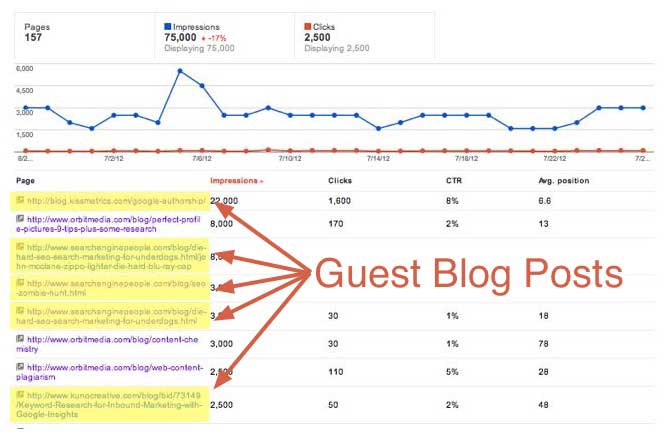Smart Web marketing combines search engine optimization (SEO) with social media. Guest-blogging is the perfect example. It's a way to promote content and your company with huge (and measurable) SEO and social media benefits. And it's fun.
First, let's recap the basics of search optimization and social media: (1) To rank well in search engines, a site needs to look authoritative, which generally means a good number of legitimate websites have linked to it; and (2) to get results in social media, you need to create meaningful connections with relevant people.
Let's See How Guest-Blogging Can Help
Guest-blogging has to sides: publishing your content on other sites (being a guest blogger) and seeking content from others for your site (blogger relations and guest-blogger outreach). They are both powerful content-marketing tactics with search marketing and social media benefits.
To see how to guest-blog and see what the search and social benefits are, let's imagine the processes and the outcomes of two bloggers: one blogger who posts only on his own site and another who embraces both approaches to guest-blogging.
Round One: Both Bloggers Create Two Posts

Blogger A has written two posts, and he publishes both on his blog. Blogger B has also written two posts, but rather than post them both on her blog, she connects with another website owner or content manager who agrees to publish one of her posts. She asks only for a link back to her site in exchange. That link is indicated by the dotted line in the diagram above.
Also, she reaches out to another writer in her field. That writer submits a new, original post, and Blogger B publishes it on her site. The guest post is indicated by the highlighted box above.
Let's see how they're doing. Although Blogger B wrote only two of the posts, she now has three posts associated with her brand. She also has a link and a few new friends.

Round Two: Both Bloggers Have Published Four Posts

Blogger A has now written and published four posts, all on his own blog. Blogger B has published two posts on external websites, both of which now have links back to her site. She's also connected with expert writers who have contributed two relevant posts that are now on her blog. And she's built connections with the people behind other websites relevant to her business.

Round Three: Both Bloggers Have Created Eight Posts

Blogger A has consistently produced and published content, but Blogger B has created a network of content, both on her site and linked to her brand. This has increased exposure to her content. She's also growing a network of connections with experts, which has increased her influence in her field. And that's what great Web marketing looks like.

Remember, SEO is about great content and great links. Social media is about real connections with real people. Guest-blogging provides both.
Great Guest Bloggers Follow Up

A considerate guest blogger pays attention to keyphrases and search rankings, even though he is writing for someone else's site. If you've written something that might rank well, that's how to make sure you leave behind a gift that keeps giving: ongoing traffic to the post.
Think about it. When you've been a guest in someone's home, leaving behind a little gift is a nice thing to do (perhaps a bottle of wine or some beer in the fridge). Guest-blogging is no different. When you're a guest (blogger) on someone's home (page), leave a thank you gift.
And nothing says "thank you" like a high-ranking guest post that drives traffic for months or years.
Google Author Stats
So, how do you see how your guest blog posts are performing in search? Simple: Google Author Stats. The rank and traffic for all of your articles will be organized into a nice report in Author Stats—as long as you've been using Google Authorship (and if you have, your profile picture will appear in search results).
Google Authorship is assigned when you use a special link to your Google+ profile from your article and add the host blog to your "contributor to" links in Google+. Here's a video that explains how to use Google Authorship and Author Stats.
Example: How Author Stats Made Me a Better Guest Blogger
Here's an example of how I use Author Stats to combine SEO and social media while guest-blogging. I helped get a guest post to rank a little higher and stayed connected with the host blog.
I wrote a guest post for SpinSucks.com about overcoming writer's block. Before I wrote it, I checked Google's Keyword Tool and found that 880 people search for "overcome writer's block" each month, so I optimized my post by using the phrase in the title, the header, and a few times in the body text.
A few weeks after the post went live, I checked Author Stats by logging into Google Webmaster Tools using my Google+ login. I scrolled through the list looking for the writer's block post.

There it was. It was getting some clicks, but the rank was 18, somewhere near the bottom of page two of search results.

The post could rank higher, but only if more pages were linking to it. Maybe I could find opportunities to create links on other pages of SpinSucks.com. I searched for "site:https://www.spinsucks.com writers block" in Google, which showed me every instance of the words "writer's block" on the host blog. I found three, each of which was an opportunity to create an internal link to the post.
With a friendly tone, I wrote to Lisa Gerber, the blog editor, and suggested she turn those instances of text into links to my writer's block post. She understood the logic and happily created the links. Since then, the rank of the post has improved a bit, fluctuating between the middle and the top of page two.
Guest Blogger Follow-Up: Step-by-Step Instructions
Let's summarize. Here are the steps for using Author Stats to be a better guest blogger. A few weeks after writing a search friendly guest post, do the following:
- Log into Google Webmaster Tools using your Google+ login.
- Click on Labs > Author Stats. You'll see a list of all the articles you've signed with rel=author and see how they are performing in Google. The list shows Impressions, Clicks, CTR (clickthrough rate), and Avg Position (rank).
- Scroll through the list and find your guest post.
- Unless it's already ranking No. 1, help the host blog find opportunities to create internal links to the post. In other words, find instances of the keyphrase on other pages by searching Google for "site:[host blog address] [target keyword]."
- Suggest the host blog create these internal links, helping the link popularity and the rank.
Author Stats shows you the rank and performance of your guest posts, allowing you to find opportunities for cooperation with the host blog to drive more traffic via search. It's a way to stay connected with the editors and show you care.
And it's my way of leaving a thank-you gift for the host blog. Maybe a few hundred extra visits are better than a six-pack in the fridge.
This article is based on an excerpt from Content Chemistry: An Illustrated Guide to Content Marketing.




